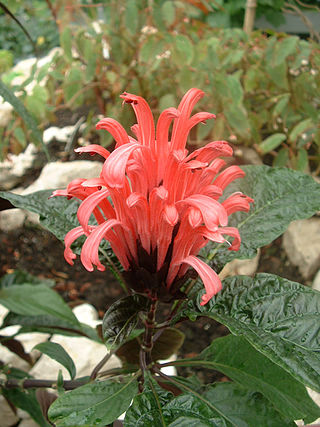
Justicia is a genus of flowering plants in the family Acanthaceae. It is the largest genus within the family, encompassing around 700 species with hundreds more as yet unresolved. They are native to tropical to warm temperate regions of the Americas, India and Africa. The genus serves as host to many butterfly species, such as Anartia fatima. Common names include water-willow and shrimp plant, the latter from the inflorescences, which resemble a shrimp in some species. The generic name honours Scottish horticulturist James Justice (1698–1763). They are closely related to Pachystachys.
Adenostemma harlingii is a species of flowering plant in the family Asteraceae. It is endemic to Ecuador. Its natural habitat is subtropical or tropical moist montane forests. It is threatened by habitat loss.
Cacosmia harlingii is a species of flowering plant in the family Asteraceae. It is found only in Ecuador. Its natural habitat is subtropical or tropical moist montane forests. It is threatened by habitat loss.
Calea harlingii is a species of flowering plant in the aster family, Asteraceae. It is endemic to Ecuador, where it is known only from one population discovered in Loja Province in 1980. It is a shrub or subshrub that grows in low-elevation forests in the Andes. It is threatened by habitat destruction.
Clibadium harlingii is a species of flowering plant in the family Asteraceae. It is found only in Ecuador. Its natural habitat is subtropical or tropical moist montane forests. It is threatened by habitat loss.
Critoniopsis harlingii is a species of flowering plant in the family Asteraceae. It is found only in Ecuador. Its natural habitat is subtropical or tropical dry shrubland. It is threatened by habitat loss.
Fleischmannia harlingii is a species of flowering plant in the family Asteraceae. It is found only in Ecuador. Its natural habitat is subtropical or tropical dry shrubland. It is a perennial herb up to 50 cm tall. It produces numerous flower heads in a branching array at the ends of the stems, each head with about 20 white disc flowers per head but no ray flowers.
Mikania harlingii is a species of flowering plant in the family Asteraceae. It is found only in Ecuador. Its natural habitats are subtropical or tropical moist montane forests and subtropical or tropical high-altitude shrubland. It is threatened by habitat loss.
Verbesina harlingii is a species of flowering plant in the family Asteraceae. It is found only in Ecuador. Its natural habitat is subtropical or tropical moist montane forests. It is threatened by habitat loss.
Aphelandra harlingii is a species of plant in the family Acanthaceae. It is endemic to Ecuador. Its natural habitat is subtropical or tropical moist montane forests. It is threatened by habitat loss.
Begonia harlingii is a species of plant in the family Begoniaceae. It is endemic to Ecuador. Its natural habitat is subtropical or tropical moist lowland forests. It is threatened by habitat loss.
Brachyotum harlingii is a species of plant in the family Melastomataceae. It is endemic to Ecuador. Its natural habitat is subtropical or tropical high-altitude shrubland.
Graffenrieda harlingii is a species of plant in the family Melastomataceae. It is endemic to Ecuador. Its natural habitats are subtropical or tropical moist montane forests and subtropical or tropical high-altitude shrubland.
Guzmania harlingii is a species of plant in the family Bromeliaceae. It is endemic to Ecuador. Its natural habitats are subtropical or tropical moist lowland forests and subtropical or tropical moist montane forests. It is threatened by habitat loss.
Justicia ianthina is a species of plant in the family Acanthaceae. It is endemic to Ecuador. Its natural habitat is subtropical or tropical moist lowland forests. It is threatened by habitat loss.
Matelea harlingii is a species of plant in the family Apocynaceae. It is endemic to Ecuador. Its natural habitat is subtropical or tropical moist montane forests. It is threatened by habitat loss.
Neriacanthus harlingii is a species of plant in the family Acanthaceae. It is endemic to Ecuador. Its natural habitat is subtropical or tropical moist montane forests. It is threatened by habitat loss.
Pitcairnia harlingii is a species of flowering plant in the family Bromeliaceae, endemic to Ecuador. It was first described by Lyman Bradford Smith in 1961. Its natural habitats are subtropical or tropical moist lowland forests and subtropical or tropical moist montane forests. It is threatened by habitat loss.
Saurauia harlingii is a species of plant in the Actinidiaceae family. It is endemic to Ecuador. Its natural habitat is subtropical or tropical moist montane forests. It is threatened by habitat loss.
Stenandrium harlingii is a species of plant in the family Acanthaceae. It is endemic to Ecuador. Its natural habitat is subtropical or tropical moist montane forests. It is threatened by habitat loss.

